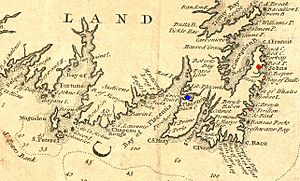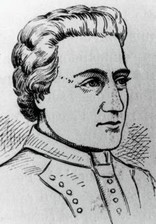Siege of St. John's facts for kids
Quick facts for kids Siege of St. John's |
|||||||
|---|---|---|---|---|---|---|---|
| Part of Queen Anne's War | |||||||
 Extract of a 1744 map showing southeastern Newfoundland. Plaisance is marked in blue, St. John's and smaller English settlements are marked in red. |
|||||||
|
|||||||
| Belligerents | |||||||
Mi'kmaq Abenakis |
|||||||
| Commanders and leaders | |||||||
| Daniel d'Auger de Subercase Josué Dubois Berthelot de Beaucours Chief Escumbuit Jean-Baptiste Hertel de Rouville Jacques Testard de Montigny |
John Moody Robert Latham |
||||||
| Strength | |||||||
| 450 Marines and Canadian Militia | 50–60 soldiers and militia | ||||||
| Casualties and losses | |||||||
| 200 | 3 killed 200 civilians captured |
||||||
The siege of St. John's was a failed attack by French forces in 1705. It happened during the winter months of Queen Anne's War. French soldiers, led by Daniel d'Auger de Subercase, tried to capture the fort at St. John's, Newfoundland.
Subercase's force included French soldiers, local militia, and Native American allies. They burned much of the town. They then tried to capture the fort for five weeks, from late January to early March 1705. However, they ran out of supplies and gunpowder. Because of this, Subercase had to stop the attack.
This siege was part of a bigger plan. The French wanted to repeat a very destructive attack from 1696. During this 1705 expedition, many English towns outside St. John's were destroyed. This led to the English attacking French settlements in return. Fishing for both sides suffered throughout the war. The war ended with France giving up its claims to Newfoundland.
Contents
Why This Happened
The island of Newfoundland was a disputed area between France and England. This was true for a long time before Queen Anne's War started in 1702. During an earlier conflict, King William's War in the 1690s, French attacks had destroyed almost all English settlements. This included the main port of St. John's. It is located on the east side of the Avalon Peninsula in southeastern Newfoundland.
After these attacks, English leaders encouraged fishermen to return and rebuild. The Treaty of Ryswick was signed in 1697. It said that England would get Newfoundland. France would keep Acadia. However, these terms changed when France rebuilt its capital in Plaisance. This town was on the west side of the Avalon Peninsula.
In 1702, English Captain John Leake attacked several French settlements in Newfoundland. But he avoided Plaisance. This was because French warships were in its harbor. In 1703, Daniel d'Auger de Subercase became the new governor in Plaisance. He took command of a small group of 150 soldiers. Their facilities were in poor condition.
After attacking Ferryland, Subercase learned of an English plan to attack Plaisance. He prepared for the assault. But the attack never happened. Admiral John Graydon called it off. Many in England saw this as a cowardly move. Graydon was later removed from service for his actions.
French Plans for Attack
In late 1704, Governor Subercase began planning an attack on the English settlements. He gathered his soldiers. He also recruited Canadiens and Abenaki people from the mainland. He asked as many settlers as possible to join the effort.
In total, his force was about 450 men. They started their journey across the peninsula on January 8, 1705. A group of over 100 men was led by Josué Dubois Berthelot de Beaucours. This group included Jacques Testard de Montigny and the Abenaki war leader Escumbuit. Both of them had been part of a French attack in 1696. Most of the group traveled by land. A small ship called a brigantine was sent around the peninsula. It carried some heavy cannons.
English Defenses at St. John's
St. John's was commanded by Lieutenant John Moody. His second-in-command was Lieutenant Robert Latham. Latham was a military engineer and a builder.
The main defenses of St. John's were two forts. One was Fort William. It was a stone fort on the north side of the harbor. It was built after the French attack in 1696. The other was the South Castle. This was also a stone fort. It was on the south side of The Narrows, which is the entrance to the harbor. This fort controlled who could enter.
Moody put Latham in charge of the South Castle. Moody himself commanded Fort William. The total defense force had between 50 and 60 men. About a dozen of these men were under Latham's command.
The Attack Begins
The French forces moved very slowly. This was because of the extreme cold and deep snow in winter. They first captured Bay Bulls and Ferryland. These were small towns south of St. John's. They took them without a fight.
Then, they moved toward St. John's. They arrived near the town on January 31. Subercase had hoped to surprise the English. But this chance was lost. His advance group came too close to the English defenses. The rest of his force was delayed by bad weather. The English fired cannons and drove them back.
Most of the town's people then ran to the safety of Fort William. Subercase had to settle for taking over the town. He waited for the brigantine ship with the heavy guns to arrive. He took some people prisoner. But he released the women and children to the fort. He hoped this would make it harder for the English to feed everyone. However, the women ended up helping a lot with the fort's defense.

After about two weeks, Subercase tried a trick. He knew that Moody and Latham had disagreements. He hoped to lower the English soldiers' spirits. He also wanted to make them surrender or gain control of Latham's fort. He sent letters to both men. One was from him to Moody. The other was from a prisoner to Latham.
The letter to Latham hinted that Moody was making a deal. Subercase's agents tried to convince Latham to leave his post. They wanted him to meet with Moody. But Latham refused. Subercase's plan did not work.
After 33 days of waiting, the ship with the heavy guns never showed up. Subercase was running low on ammunition and food. So, he stopped the siege. He destroyed the houses and fishing areas in the town. Then, he returned to Plaisance. He took 200 civilian prisoners with him. Subercase sent Montigny and 70 men to continue attacking English settlements for the rest of the winter.
What Happened Next
The French attack took 1,200 prisoners in total. Most of them were released because the French did not have enough food. The French also destroyed 40 cannons, 2,000 small fishing boats, and 200 wagons. But they failed to capture the main English fort.
John Moody went back to England in late 1705. He was rewarded with a promotion in the Coldstream Guards. He argued with Latham, saying Latham had managed the fort's work poorly. His complaints led to Latham being called back.
Subercase continued to help the French colony grow in 1705. It did well despite the war. He was rewarded for his efforts. He received the Order of Saint Louis and became the governor of Acadia. There, he was in charge of defending Port Royal. He successfully fought off British attacks in 1707. But he was later forced to surrender to a much larger force in 1710.
Subercase's replacement in Plaisance was Philippe Pastour de Costebelle. He arranged for the prisoners from the siege to be exchanged. He then successfully captured St. John's in January 1709.
France gave up its claims to Newfoundland in the 1713 Treaty of Utrecht. Under Costebelle's guidance, French settlers moved from Newfoundland to Louisbourg.
Today, the place where Fort William stood is a National Historic Site of Canada. There is a plaque there. The South Castle location is part of the Signal Hill National Historic Site.


